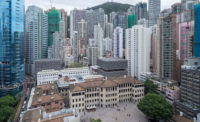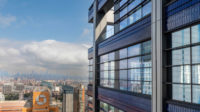To understand China’s transition from a manufacturing nation to one driven by information and creative services, go to Shenzhen and walk around the Ming-De Academy, located on a hilly site on the far eastern edge of the city. A private high school with slightly more than 300 students, Ming-De occupies the grounds of the old Honghua Dyeing Mill, an industrial behemoth that opened in 1989 and closed just 14 years later. Today, the mill’s once-crumbling reinforced-concrete buildings have been skillfully transformed into attractive spaces for educating a new generation of Chinese, who require access to the latest digital technologies.
Additional Content:
Jump to credits & specifications
He Jianxiang and Jiang Ying, the husband-and-wife team behind O-office Architects, have been rethinking their nation’s industrial heritage for more than a decade, adapting old factories in their native Guangdong Province, where China’s post-Mao economic resurgence began in the 1980s. Their own studio sits on top of a former beer factory’s concrete silo structure in Guangzhou, about 85 miles northwest of Shenzhen.
In 2014, prior to their creation of the high school, the firm converted a pair of buildings at the Honghua Dyeing Mill into an art gallery and artist studios—Phase 1 of a creative-services hub called iD Town. Now O-office has recycled nearly a dozen structures around iD Town’s core to create Ming-De Academy, a 253,000-square-foot complex encompassing a large classroom building, a library, a science center, a student center, housing for students and faculty, and recreational facilities. The school, which has 50 teachers and 35 nonteaching staff, eventually plans to grow to 600 students.
To connect the buildings and weave them into a coherent campus, He and Jiang created a series of gardens, plazas, promenades, and bridges on the sloping wooded site. In the area’s subtropical climate, trees and vines grow rapidly, so the architects used the natural flora as an integral part of their landscape plan—employing large species for shade, for example, and snaking an elevated walkway through the forest canopy. Because the buildings spread out in a great arc on the sprawling grounds—and the distance from the student center on the northeast to the classroom building on the southwest runs almost half a mile—O-office approached the outdoor spaces as a sequence of discrete experiences that wouldn’t overwhelm students or visitors. “Our overall strategy was to work on the ‘in-between,’ on the interrelation between different buildings, between buildings and topography, and between buildings and nature,” say He and Jiang.
Instead of trying to erase the imprint of the old factory in a rush to modernization, O-office “maintained the identity and contrast of the new and the old.” To do this, the architects kept as much of the fabric of the old buildings as possible—from outdoor corridors on some of the housing blocks to the mottled plaster facades on most of the structures—while adding distinctly new elements such as perforated steel screens, projecting steel window frames, and colorful entries. Most of the existing buildings were structurally sound but required steel reinforcing, due to higher safety standards for educational facilities. For Phase 1 of iD Town, the architects had established stark contrasts between the dilapidated fabric of the factory and a series of modern cubes inserted within it for use as artists’ studios and a café. At the school, they used a more “delicate” treatment to create greater spatial continuity and a more “intimate hospitality.” Throughout the school, they applied a palette of simple finishes such as drywall, colorful paints, and clear glass that gives the interiors a sleek, contemporary vibe.
While each building on the campus required specific responses to adapt it to its new use, the architects were able to apply some common strategies to multiple locations. The three student dormitories, for example, were all refashioned from existing worker dormitories, so O-office could retain much of the old buildings’ plans and simply add new staircases, faceted entries, and some shared terraces. For the faculty housing block, the architects wrapped the old managers’ apartment building with steel grating to create an interstitial space for private balconies and plantings. He and Jiang kept the arched openings of the factory’s canteen for the new student center, but reframed them in steel and added new glazing.
Other pieces required more radical transformations, such as the factory’s generator building, which O-office converted into the library by embedding a set of raised book-storage spaces in the old structure and cantilevering perforated Cor-Ten boxes beyond the building envelope to serve as small courtyards open to the sky. For the science building, the architects added a new roof canopy with a mirrored soffit to the old dye-storage structure, carved out an internal atrium, and placed a teaching garden on top. Jiang and He took the factory’s enormous fabric warehouse and turned it into the academic building by designing a long, tube-like space to serve as the main corridor connecting all of the classrooms, and punching out a series of skylights in the roof with small atria below. The addition of lime-green walls and ceilings, as well as interior glass partitions, project the image of a 21st-century learning environment.
Recrafting the outdoors was as important to O-office as adapting the buildings. The architects turned the side of one hill into an amphitheater facing the library, and transformed the barren concrete terrace outside the old canteen into a garden and landscaped plaza to serve as an open-air extension of the new student center. Walking from one part of campus to another, students experience a sequence of outdoor rooms and pathways that push them to engage with the rolling topography, lush plantings, and old architecture. While the architects had originally envisioned the school and iD Town as a seamless community of learning and creative spaces, security concerns have forced the school to limit access to its campus buildings. Ming-De Academy, though, shows how architecture can chart a path from heavy industry to a knowledge-based economy—layering new possibilities on top of an obsolete past.
CreditsArchitect: O-office Architects, Loft E8-7,63Xizeng Road Liwan District Guangzhou China, +86 20 85577225, www.o-officearch.com
Personnel in architect's firm who should receive special credit: Chief Architects: He Jianxiang, Jiang Ying; Project Architect: Dong Jingyu,Huang Tong; Design Team: Huang Chengqiang, Chen Xiaolin, He Wenkang, Zhang Wanyi, Deng Mincong, Lin Licong, Zhang Tao, Fan Zhen
Engineers: Shenzhen Yizhou Architectural & Engineering Design Ltd
Consultants: Facade: Shenzhen Huajian Steel Construction: Shenzhen Kaihua Building Building Intelligent: None Landscape: Guangzhou Shangdian Design Sign Design: W.W.D.
General contractor: Jiangsu Huajian Construction co. Ltd, Teyida interior construction co.Ltd
Photographer: Zhang chao, Wu Siming, Huang Chengqiang, He Zhenzhong |
SpecificationsExterior Cladding Metal/glass curtain wall: AVIC SANXING Curtain wall: Rincon
Doors Fire-control doors, security grilles: Fangda Security technology
Interior Finishes Paneling: Formica, ETERPAN Floor and wall tile: TPY Resilient flooring: Nora, Armstrong
Furnishings Office furniture: Edimas, DGJS Teaching furniture: DGJS Dormitory furniture: DGJS
Lighting Interior ambient lighting: RH lighting Exterior: XiangYu lighting
Conveyance Elevators/escalators: SH Mitsubishi
Energy Electric ventilator: JT Environmental Technology |




































